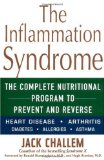 Weight issues, heart disease, arthritis, diabetes, allergies of various types — including food, asthma, some cancers, and many other diseases have a common tie. Inflammation. Which is triggered by inflammatory foods in one’s diet. The Inflammation Syndrome — “the cumulative effect of low-grade inflammation–including the aches and pains that we all experience–that grows into chronic, debilitating disease” — is a must-read book to create long-term good health.
Weight issues, heart disease, arthritis, diabetes, allergies of various types — including food, asthma, some cancers, and many other diseases have a common tie. Inflammation. Which is triggered by inflammatory foods in one’s diet. The Inflammation Syndrome — “the cumulative effect of low-grade inflammation–including the aches and pains that we all experience–that grows into chronic, debilitating disease” — is a must-read book to create long-term good health.
I highly recommend The Inflammation Syndrome: The Complete Nutritional Program to Prevent and Reverse Heart Disease, Arthritis, Diabetes, Allergies, and Asthma, a well-written book, to prevent or reverse these health issues. It’s imperative to learn what causes inflammation and how to reduce it, and author, Jack Challem, does a fantastic job of describing the issues and laying out a fifteen-step diet to reduce inflammation. He is a leading health and medical writer with articles published in several journals, and he’s also a contributing editor for two magazines, as well as consumer health publications.
A dear friend, who has osteo and rheumatoid arthritis, food allergies, fibromyalgia, thyroid issues, etc., read this book, liked it, and decided to go on the anti-inflammatory diet detailed in it. She basically said I was already doing the diet, so I borrowed the book to see what it said. I wish I had found this book much sooner because I could have prevented or lessened the increased inflammation I am dealing with now because of hidden food allergies, which have created a lot of other problems. Independently, in February, I actually did have food allergy testing of the delayed-response type, IgG, but I wish now that I had also requested an IgE type for immediate-response food allergies.
The book is broken down into four parts after the introduction: “Part I The Inflammation-Disease Connection,” “Part II The Anti-Inflammation Syndrome Diet Plan,” “Part III The Anti-Inflammation Syndrome Supplement Plan,” and “Putting Anti-Inflammation Syndrome Nutrients to Work for You.” In Part I, Challem details what he means by “Inflammation Syndrome,” discusses the inflammation triggers and dietary causes, talks about balancing a diet that’s out of balance, and gives details on what’s wrong with anti-inflammatory drugs.
In Part II, he discusses the fifteen steps to fight the inflammation syndrome and gives menu plans and recipes. I’ve found that successful dietary changes require great recipes and meal planning, so this section is greatly appreciated. However, if I were starting this diet from scratch, I’d love to see more recipes and meal plans. I did notice that Challem has a new book, which may remedy this problem.
In Part III, Challem talks about good fats that rev up the body’s natural anti-inflammatory processes. He also talks a great deal about nutritional support, such as vitamins B, C, D, and E, as well as glucosamine, chondroitin, and other supplements, and presents a lot of research about various health issues and why certain supplements are helpful. I found this section particularly helpful to me, as I’m considering discussing some additional supplements with my physician, who is knowledgeable about nutrition. My doctor actually put me on most of the supplements that Challem recommends for my particular problems.
Before this last section, Challem focused on the leading dietary causes and solutions for the Inflammation Syndrome; however, in this last part, he shifts to specific diseases and conditions that are caused or exacerbated by inflammation. For each condition, he typically describes the condition, lists the standard treatment, discusses dietary changes and nutrients that can help, and includes some information on what else might help.
At the end of the book, he adds a short afterword, two appendices, and a lengthy list or references. Appendix A has a list of medical tests to assess inflammation, which is a great bonus. Appendix B has a list of anti-inflammatory products and where you can purchase them.
I highly recommend this book for everyone who is interested in weight loss, as well as preventing and reversing heart disease, arthritis, diabetes, allergies of various types — including food, asthma, some cancers, and many other diseases that have a basis in inflammation. However, I want to add that I recommend making dietary changes slowly for long-term success. Too many changes at once can be overwhelming and lead to dissatisfaction. I spent nearly two years making changes to my diet, which has become the Paleo diet (which Challem does talk about), albeit I hadn’t read a book like this that had the steps spelled out. For the past month, I’ve been grappling with the rotation diet, which my doctor gave me for my numerous food allergies.
Rating: ♥♥♥♥♥ (5 out of 5)